Fisher Body Number Plate - 1970
[ Preface ] | [ 1964 ] | [ 1965 ] | [ 1966 ] | [ 1967 ] | [ 1968 ] | [ 1969 ] | [ 1970 ] | [ 1971 ] | [ 1972 ]
[ Arlington ] | [ Atlanta ] | [ Baltimore ] | [ Flint ] | [ Kansas City ] | [ Van Nuys/Los Angeles ] [ Oshawa ]
Introduction: For quite some time I’ve had an intense interest in Fisher Body Number plates, a.k.a. trim tag, cowl tag, firewall tag, etc. for 1964 through 1972 Chevelles - hereafter referred to as ‘trim tag’ since that seems to be most common moniker for these little jewels. Their diversity, not only between the different years but between the different plants in a given year, has always fascinated me. This page deals only with 1970 Chevelle trim tags.
The seventh model year of the Chevelle, 1970, saw its final assembly production occur at 6 plants in the U.S. - Arlington, Texas - Atlanta, Georgia - Baltimore, Maryland - Flint, Michigan - Kansas City, Missouri - and Van Nuys (or Los Angeles as some prefer) - plus Oshawa, Ontario in Canada. The 1970 model year is the first year Arlington would assemble Chevelles in this era and marks the return of the Van Nuys, California plant and the demise of the Fremont, California plant that had been assembling Chevelles since 1964.
I’ll not attempt to decode what each trim code, paint code, and where applicable, group option codes in this series represent. Click on any year's link in the navigation menu at the top of the page and choose the appropriate link on that year's home page where you’ll find links for detailed information for interior, paint, and group option codes.
All research to date indicates that each Fisher Body plant, with the exception of Baltimore, assigned body numbers in sequential order regardless of Fisher Body style numbers as they did in previous years. However, body numbers did not run sequentially from 00001 through some final production as they tended to do in earlier years. Whatever numbering system was used (and each plant's numbering system was unique to that plant), the reasoning is probably a result of the essential demise of Fisher Body as a separate entity within General Motors in 1968 when they were reorganized into the General Motors Assembly Division (GMAD) and many Fisher Body plant operations were absorbed.
Oddly, Baltimore did not use the body number from the build sheet on the trim tag but rather a data processing tracking number found in block #24 of the build sheet.
Arlington, Atlanta, Flint, and Van Nuys trim tags continued to be 1-3/4" x 4" in size where Baltimore and Kansas City continued the change in 1969 to the 2-3/16" x 3-1/2" tag.
The Fisher Body unit number has nothing to do with the vehicle identification number (VIN) assigned by GM at final assembly and if any were to match, it’d be a coincidence.
With that, let's begin 1970.
The 1970 Fisher Body Number plate for Arlington, contained only basic information and no frills. Arlington had no production reported in September, October, or November of 1969. According to GM News, the Monte Carlo was not built at the Arlington plant until 1972.


The first information line contains the abbreviation ST (for Style) followed by the model year (70), a hyphen, and the Fisher Body style number. Next is the designation for the plant location, BT for Arlington, and the Fisher Body unit number followed by BDY. It should be noted that the Fisher Body style number (13637 for a Malibu sport coupe and 13636 for a Concours station wagon in the examples) has nothing to do with the GM VIN series/model designation. That means the 13636 does not indicate a V8 engine just because the third digit is an even number. Fisher Body did not care if the car was to receive a V8 or L6 engine. Generally, the Fisher Body unit number, 10361 and 01695 in these cases, was sequential by body style number although it's not known what numbers were used to begin the sequencing.
The second information line contains the abbreviation TR (for Trim) followed by a 3-digit number indicating the seat type (bucket or bench), color and material. Next is a pair of 2-digit numbers indicating the exterior paint color with the lower body color represented by the first pair and the upper body color represented by the second pair, and finally the abbreviation PNT. When the second pair is replaced by a single letter, this single letter indicates a vinyl or convertible top color.
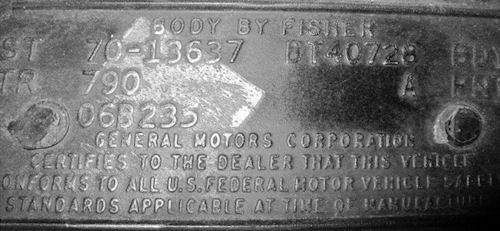
Special order paint Chevelles
from Arlington is indicated
with a blank space.
The third information line contains the body assembly date consisting of the month as a 2-digit number and a single letter (A…E) designating the week. When the month is a single digit month (January through September) the month number is padded with a leading zero (0) such as 01, 02, 03, etc. In the examples 02D is the 2nd month (February) and “D” represents the 4th week and 05D is the 5th month (May) and "D" represents the 4th week.
Following the body assembly date is a 3-digit number that corresponds to the last 3 digits of the data processing number found in block #10 of the build sheet.
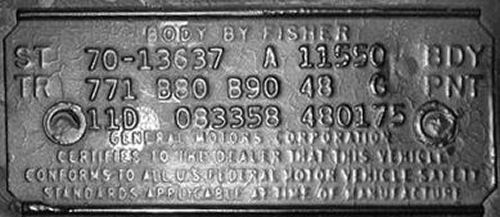

The first information line contains the abbreviation ST (for Style) followed by the model year (70), a hyphen, and the Fisher Body style number. Next is the designation for the plant location, A for Atlanta, a space, and the Fisher Body unit number followed by BDY. It should be noted that the Fisher Body style number (13637 for a Malibu sport coupe in the examples) has nothing to do with the GM VIN series/model designation. That means the 13637 does not indicate a V8 engine just because the third digit is an even number. Fisher Body did not care if the car was to receive a V8 or L6 engine. Generally, the Fisher Body unit number, 11550 and 52562 in these cases, was sequential although it's not known what number was used to begin the sequencing. To date, no 1970 Atlanta trim tag has been found with an odd third digit in the style.
Also found, generally in the top right corner and often very faint, is a hand stamped number that is believed to be a body assembly platform number.
The second information line contains the abbreviation TR (for Trim) followed by a 3-digit number indicating the seat type (bucket or bench), color and material.
I only have Malibu sport coupe trim tags but I'm certain these next two RPO codes would not apply to other styles; B80 is the Roof Drip Molding and B90 is the Door Window Frame Molding.
Next is a pair of 2-digit numbers indicating the exterior paint color with the lower body color represented by the first pair and the upper body color represented by the second pair, and finally the word PNT. When the second pair is replaced by a single letter, this single letter indicates a vinyl or convertible top color. To date, no special order paint trim tag has been uncovered for Atlanta so it's uncertain at this time just how it was depicted on the trim tag.
The third information line contains the body assembly date consisting of the month as a 2-digit number and a single letter (A…E) designating the week. When the month is a single digit month (January through September) the month number is padded with a leading zero (0) such as 01, 02, 03, etc. In the examples 11D is the 11th month (November) and “D” represents the 4th week and 06A is the 6th month (June) and "A" represents the 1st week.
Next are two sets of 6-digit numbers. The first 6-digit number is a data processing number found in block #24 of the build sheet. The second 6-digit number is a concatenation of a 2-digit (from block #10) and a 4-digit (from block #24) data processing numbers also found on the build sheet.
The first 2-digit number is a production date sequence number and will range between 01 and 99 then starts over with 01 for the 100th production day. Atlanta began production sequencing on Wednesday September 17, 1969. It's not known (yet) what the 4-digit number represents. To date the highest number found on a build sheet is 0634.
These numbers do not depict option codes or the like so their significance today is of no consequence. They are handy to match a car's trim tag to any build sheet that may be found in the car as these numbers should appear in the respective blocks on the build sheet.
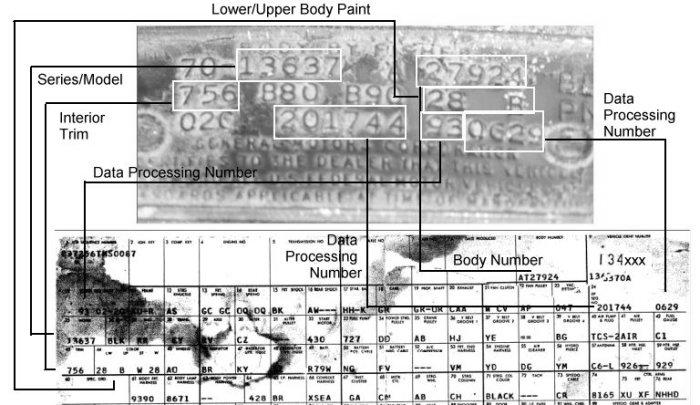
Baltimore differed from every other plant in 1970 in the respect they did not use the body number from the build sheet but rather a data processing number from block #24. Baltimore used a Fisher Body style that corresponded with the GM VIN series/model identification.

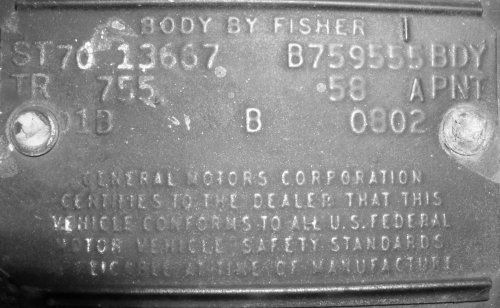

To the right of the embossed BODY BY FISHER is a 1- or 2-digit number but its meaning is unknown at this time.
The first information line contains the abbreviation ST (for Style) followed by the model year (70), a hyphen, and the Fisher Body style number. Next is the designation for the plant location, B for Baltimore, and the data processing number from block #24 of the build sheet followed by BDY. This data processing number does not appear to be sequential or follow any logical pattern.

Note the 13136 style number on the bottom tag. This indicates that Baltimore did use the same style number on the trim tag that would appear on the VIN; that is, this particular Nomad wagon is an L6-engined Chevelle.

Here is another example of a trim tag with an odd 3rd-digit, a 13380 standard El Camino.
The second information line contains the abbreviation TR (for Trim) followed by a 3-digit number indicating the seat type (bucket or bench), color and material. Next is a pair of 2-digit numbers indicating the exterior paint color with the lower body color represented by the first pair and the upper body color represented by the second pair, and finally the word PNT.


If there are one or two hyphens in the paint code positions it indicates the car was ordered with the special paint option as in the examples above with -- B and -A. The significance of a double hyphen as opposed to the single hyphen is unclear. See the paint code page for more information on special order paint.
The third information line contains the body assembly date consisting of the month as a 2-digit number and a single letter (A…E) designating the week. When the month is a single digit month (January through September) the month number is padded with a leading zero (0) such as 01, 02, 03, etc. Often the leading zero is obscured by the rivet on January through September trim tags.
Following the body assembly date are some letters (from none to 2) that are under research as to their meanings. The following are only conclusions drawn to date and not backed by any documented facts. These are believed to pertain to either interior or exterior (or maybe both) trim brightwork based on the body style by Fisher.
The letter(s) are listed along with series and body styles on trim
tags I currently have. If you have any 1970 Baltimore Chevelle trim
tags of any series not listed or tags of any series listed but with
different letters, please feel free to contact me with this information
via the Contact link in the navigation
bar.
No letters - 13136 Nomad station wagon, 13380 El Camino
B - 13637 Malibu sport coupe, 13667 Malibu convertible, 13680 Malibu
El Camino
BD - 13637 Malibu sport coupe, 13680 Malibu El Camino
B L - 13680 Malibu El Camino
The 1970 Fisher Body Number plate for Flint, contained only basic information and no frills. Flint makes a one year return to Chevelle production for 1970. Although there were 13,088 units reported by GM for September 1969, there was no reported production for October, November, or December of 1969. Oddly, even with Flint's shortened production year the Flint plant still produced more Chevelles (87,922) than Atlanta (82,496).
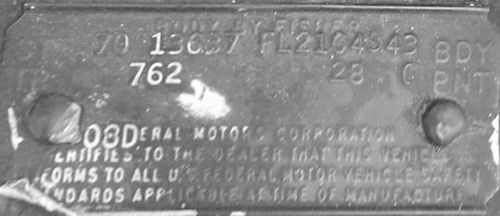
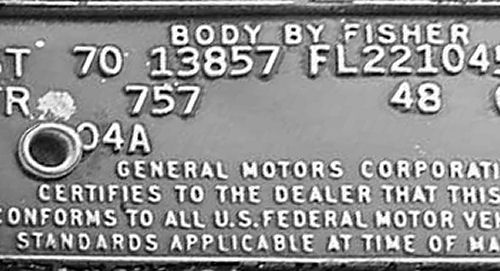
The first information line contains the abbreviation ST (for Style) followed by the model year (70) and the Fisher Body style number. Next is the designation for the plant location, FL2 for Flint, and the Fisher Body unit number followed by BDY. It should be noted that the Fisher Body style number (13637 for a Malibu sport coupe and 13857 for a Monte Carlo in the examples) has nothing to do with the GM VIN series/model designation. That means the 13637 does not indicate a V8 engine just because the third digit is an even number. Fisher Body did not care if the car was to receive a V8 or L6 engine. Generally, the Fisher Body unit number, 104343 and 210458 in these cases, was sequential although it's not known what number were used to begin the sequencing.
The second information line contains the abbreviation TR (for Trim) followed by a 3-digit number indicating the seat type (bucket or bench), color and material. Next is a pair of 2-digit numbers indicating the exterior paint color with the lower body color represented by the first pair and the upper body color represented by the second pair, and finally the word PNT. When the second pair is replaced by a single letter, this single letter indicates a vinyl or convertible top color.
The third information line contains the body assembly date consisting of the month as a 2-digit number and a single letter (A…E) designating the week. When the month is a single digit month (January through September) the month number is padded with a leading zero (0) such as 01, 02, 03, etc. In the examples 08D is the 8th month (August) and “D” represents the 4th week and 04A is the 4th month (April) and "A" represents the 1st week.


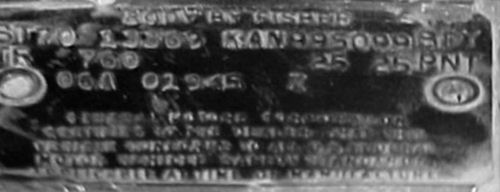
The first information line contains the abbreviation ST (for Style) followed by the model year (70) and the Fisher Body style number. Next is the designation for the plant location, KAN for Kansas City, and the Fisher Body unit number followed by BDY. It should be noted that the Fisher Body style number (13637 for a Malibu sport coupe and 13437 for a Chevelle sport coupe in the examples) does correspond with the GM VIN series/model designation as indicated by the last trim tag with a style number of 13369. Generally, the Fisher Body unit number, 359123, 749741, and 995099 in these cases, was sequential although it's not known what number were used to begin the sequencing. I do have several examples where this body number is not sequential in nature.
The second information line contains the abbreviation TR (for Trim) followed by a 3-digit number indicating the seat type (bucket or bench), color and material. Next is a pair of 2-digit numbers indicating the exterior paint color with the lower body color represented by the first pair and the upper body color represented by the second pair, and finally the word PNT. When the second pair is replaced by a single letter, this single letter indicates a vinyl or convertible top color.
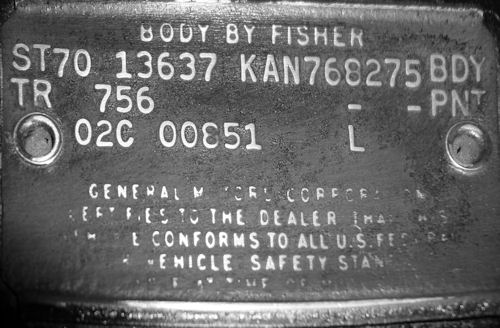
If there are one or two hyphens in the paint code positions it indicates the car was ordered with the special paint option as in the example above with - -. See the paint code page for more information on special order paint.
The third information line contains the body assembly date consisting of the month as a 2-digit number and a single letter (A…E) designating the week. When the month is a single digit month (January through September) the month number is padded with a leading zero (0) such as 01, 02, 03, etc.
Next is a 5-digit number. This is actually a concatenation of the 4-digit number found in block #24 of the build sheet and a single digit representing the work day of the week of production (1...5).
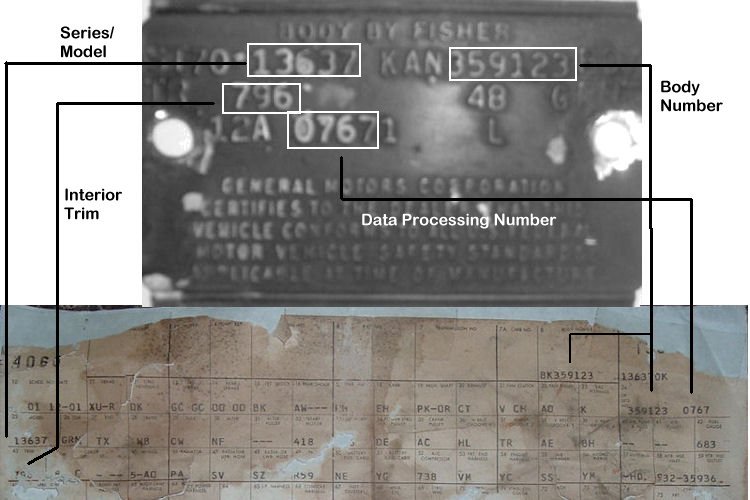
Following the body assembly date and the data processing code(s) are some letters (from none to 2) that are under research as to their meanings. The following are only conclusions drawn to date and not backed by any documented facts. These are believed to pertain to either interior or exterior (or maybe both) trim brightwork based on the body style by Fisher.
The letter(s) are listed along with series and body styles on trim
tags I currently have. If you have any 1970 Kansas City Chevelle trim
tags of any series not listed or tags of any series listed but with
different letters, please feel free to contact me with this information
via the Contact link in the navigation
bar.
No letters - 13437 Chevelle sport coupe, 13637 Malibu sport coupe, 13480
Chevelle El Camino, 13680 Malibu El Camino
L - 13637 Malibu sport coupe, 13667 Malibu convertible, 13680 Malibu
El Camino
L W - 13667 Malibu convertible, 13680 Malibu El Camino
Z - 13369 Chevelle 4-door sedan, 13480 Chevelle El Camino
It has been reported that sometime during the 1970 model year Kansas City began coding the hood and deck stripe colors on their trim tags with "B" or "W" for black or white respectively. This hasn't been confirmed with any GM documentation or enough examples to draw a concrete conclusion.
Van Nuys/Los Angeles California

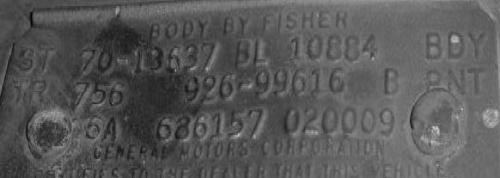
The first information line contains the abbreviation ST (for Style) followed by the model year (70), a hyphen, and the Fisher Body style number. Next is the designation for the plant location, BL for Van Nuys, and a data processing number that does not appear to be sequential or follow any logical pattern.
The second information line contains the abbreviation TR (for Trim) followed by a 3-digit number indicating the seat type (bucket or bench), color and material. Next is a pair of 2-digit numbers indicating the exterior paint color with the lower body color represented by the first pair and the upper body color represented by the second pair, and finally the word PNT. When the second pair is replaced by a single letter, this single letter indicates a vinyl or convertible top color.
If there is a 3-digit number followed by a hyphen and then a 5-digit number in the paint code position it indicates the car was ordered with the special paint option as in the example above with 926-99616; if the car has a convertible or vinyl top, that color will be designated with a letter. The embossed numbers are the mixing formula for DuPont paint. See the paint code page for more information on special order paint.
The third information line contains the body assembly date consisting of the month as a 2-digit number and a single letter (A…E) designating the week. When the month is a single digit month (January through September) the month number is padded with a leading zero (0) such as 01, 02, 03, etc. In the examples 01C is the 1st month (January) and “C” represents the 3rd week and 06A is the 6th month (June) and "A" represents the 1st week.
Next are two sets of 6-digit numbers. The first 6-digit number is a data processing number found in block #24 of the build sheet. The second 6-digit number is a concatenation of a 2-digit (from block #10) and a 4-digit (from block #24)data processing numbers also found on the build sheet. They do not depict option codes or the like so their significance today is of no consequence. They are handy to match a car's trim tag to any build sheet that may be found in the car as these numbers should appear in the respective blocks on the build sheet.
As in 1969, Oshawa trim tags were embossed with MADE IN CANADA across
the top row and
BODY BY FISHER
GENERAL MOTORS CERTIFIES TO THE DEALER THAT
THIS VEHICLE CONFORMS TO ALL U.S. GENERAL
MOTORS VEHICLE SAFETY STANDARDS APPLICABLE AT
TIME OF MANUFACTURE
on the bottom.
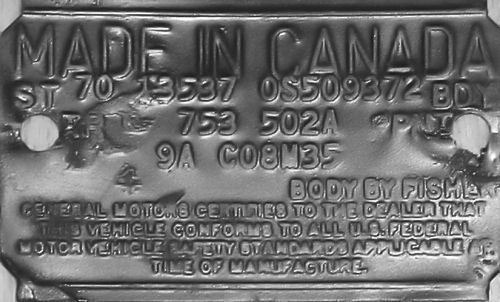

The first information line contains the abbreviation ST (for Style) followed by the model year (70) and the Fisher Body style number. Next is the designation for the plant location, OS for Oshawa, and a data processing number that appears to be sequential regardless of the style number.
The second information line contains the abbreviation TR (for Trim) followed by a 3-digit number indicating the seat type (bucket or bench), color and material. Next is a pair of 2-digit numbers indicating the exterior paint color with the lower body color represented by the first pair and the upper body color represented by the second pair, and finally the word PNT. When the second pair is replaced by a single letter, this single letter indicates a vinyl or convertible top color.
The third (and fourth if applicable) information lines contain the body assembly date consisting of the month as a 2-digit number and a single letter (A…E) designating the week. When the month is a single digit month (January through September) the month number is not padded with a leading zero (0) such as 1, 2, 3, etc. In the examples 9A is the 9th month (September) and “A” represents the 1st week and 11A is the 11th month (November) and "A" represents the 1st week.
Note the very early trim tag shows a vinyl top code on the trim/paint line as 2A where the later tag shows just B. The early trim tag is a carryover format from 1969.
Next are some RPO codes the car is equipped with. One of note on the second trim tag is RPO Z25 which depicts the SS396 option so this car is a known SS-optioned Chevelle.

 Home
Home Decode
Decode Tech
Tech Tools
Tools Dale's Coins/CDs
Dale's Coins/CDs Contact
Contact Chevelle
of the Month
Chevelle
of the Month Things
For Sale
Things
For Sale Custom
Stickers
Custom
Stickers